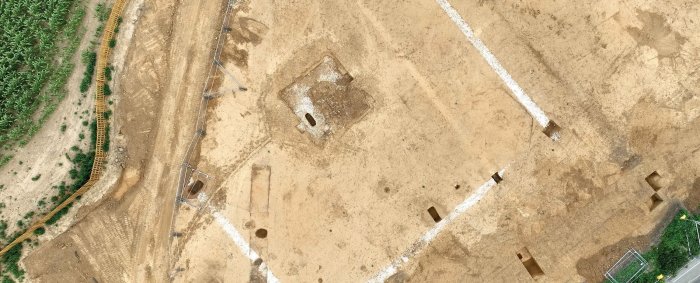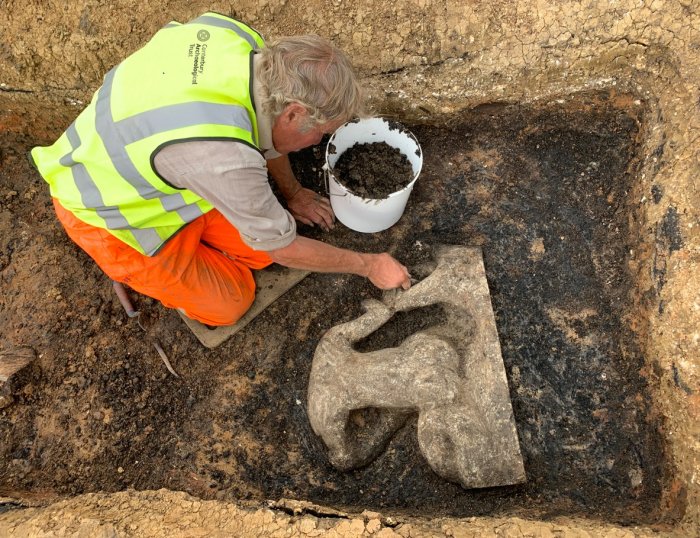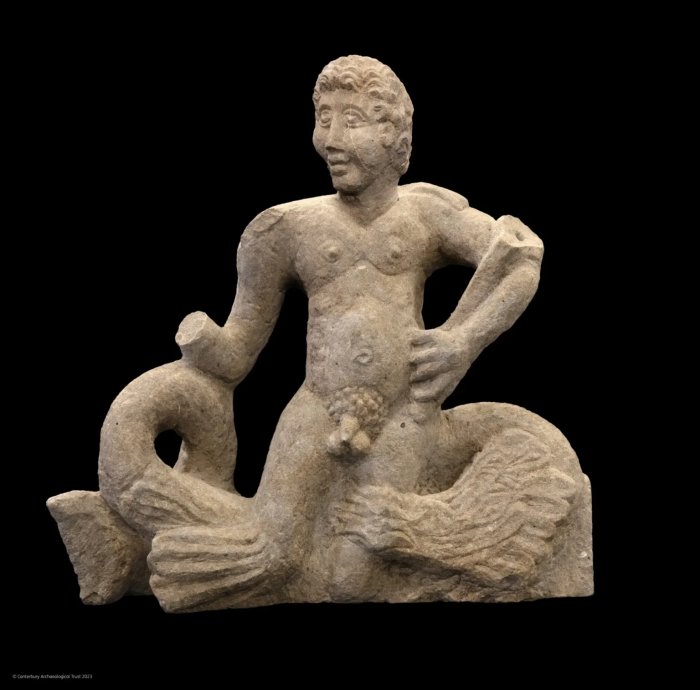Jan Bartek – AncientPages.com – Archaeologists from the Canterbury Archaeological Trust (CAT) have found a spectacular statue of the Roman sea god Triton during their excavations in connection with a new housing development being brought forward jointly by Moat Homes (Moat) and Chartway Partnerships Group (Chartway) adjacent to the A2 London Road (which follows Roman Watling Street) at Teynham in Kent.

Archaeologists are excavating a large Roman Mausoleum in Kent, England.
The excavations have discovered a mausoleum set in a walled and ditched enclosure alongside what was once the main road between London and the Roman ports of Richborough and Dover.
The site was first found during trial trenching in 2017 when two perpendicular fragments of chalk wall foundation and two urned Roman cremation burials were discovered.
As a result of these findings, Swale Borough Council, following advice from archaeologists at Kent County Council Heritage Conservation (KCC Heritage Conservation), placed a planning condition for an archaeological excavation focused at the site of a planned roundabout alongside the A2 road.
Following site stripping and partial archaeological excavation the fragments of wall identified in 2017 were found to be elements of a 30m square walled enclosure around a c.8m square structure. Further excavation suggested the structure relates to a Roman mausoleum whose demolition fills contained a Roman coin of c.320 to 330 AD.
The stone walled enclosure was set within a wider c.65m by 70m outer precinct enclosure ditch extending southwards to flank the former Roman road, whose probable roadside ditch was also partially exposed immediately adjacent to the A2.
The Spectacular Archaeological Finds
Several Roman and possibly later burials were identified during the excavation both within and immediately adjacent to these enclosures, some of which contained grave goods. The most spectacular find was a unique stone statue of sea god Triton, son of Poseidon/Roman Neptune (or a Triton, one of the minions of Neptune).

Credit: Canterbury Archaeological Trust (CAT)
The statue was found ritually placed within a disused clay-lined water tank, along with burnt fill material, beyond the south-east corner of the outer ditched enclosure (where the enclosure takes a double ditched form possibly to define a track heading north-east from the main Roman road).
A further possible small (c.1m square) monument or statue base was found to the south of the walled inner enclosure. These ᴀssociations suggest the enclosure complex and central mausoleum was a funerary site of a wealthy local family (possibly ᴀssociated with a Roman villa found previously at Bax Farm further to the north) and dedicated to Roman maritime deities.
The Roman Statue Of Triton
The most spectacular find was a unique stone statue of sea god Triton, son of Poseidon/Roman Neptune (or a Triton, one of the minions of Neptune). The statue was found ritually placed within a disused clay-lined water tank, along with burnt fill material, beyond the south-east corner of the outer ditched enclosure (where the enclosure takes a double ditched form possibly to define a track heading north-east from the main Roman road).

Credit: Canterbury Archaeological Trust (CAT)
A further possible small (c.1m square) monument or statue base was found to the south of the walled inner enclosure. These ᴀssociations suggest the enclosure complex and central mausoleum was a funerary site of a wealthy local family (possibly ᴀssociated with a Roman villa found previously at Bax Farm further to the north) and dedicated to Roman maritime deities.
See also: More Archaeology News
The Triton statue has been carefully lifted and removed from the site for initial conservation works which have revealed the fascinating detail and craftsmanship of the piece. Further research into the statue itself and the circumstances of its ritual burial are on-going.
Written by Jan Bartek – AncientPages.com Staff Writer





